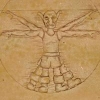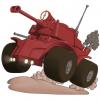To add to what was already said:
Start with a simpler test model to see
a) if you idea of how to build your models actually work in your engine, are importable and animatable
b) if your idea really work for your game design and art concept
c) to get some expierience... everything is easier the second time.
To give you an example: I am currently in the process of building a prototype for a racing / vehicle combat game. My first test vehicle was optimized to have as little separate parts as possible, as I already knew that each separate mesh would be drawn in its own draw call, increasing rendering overhead a lot.
What I didn't know was that you can combine the meshes into a single mesh in the engine, and by making that mesh a skinned one, you can still translate and rotate the parts relative to each other, all within a single drawcall (or at least just as many as for a singular mesh).
Now, suddenly I can go much higher on the amount of moving parts. My suspension / shock absorbers were single piece meshes combined with the body mesh, as I though you would barely see it. Turns out they are much more visible inside my prototype than I thought, and they look really off against the soft suspension movments my wheels follow.
So I will from now on create fully functional Suspensions. My second vehicle still in production already has that, my first test vehicle will be reworked to that standart.
Just an example. My point is, don't believe that you will be able to model perfection from the start. Start small, don't be afraid to redo parts later on or plain throw away / mothball a model that does not work, and practice, practice, practice.
You will have to find the answers to this kind of questions the hard way to some extent anyway... nobody can tell you what exactly is the perfect solution for YOUR game idea in YOUR engine. They can give you best practices, but chances are you will have to adapt them to suit your needs.
So just go ahead, come up with a simple concept model to test both solutions, see if you get stuck somewhere, come back with the questions generated by this testing.
Then, when you have finished a simpler version and have it running fine in your engine, tackle your REAL target model. Because then you know how your Workflow should look like, and can spend the many hours ad days needed for a high quality model.
Just my 2 cents








